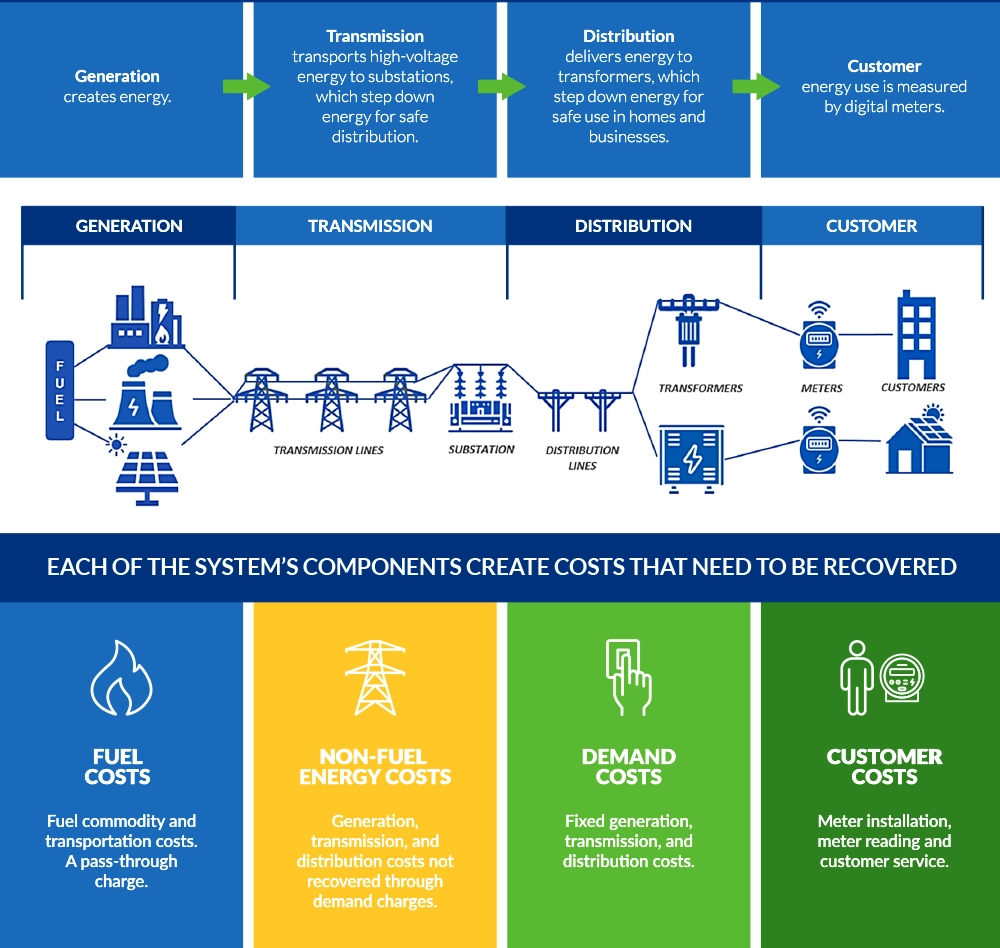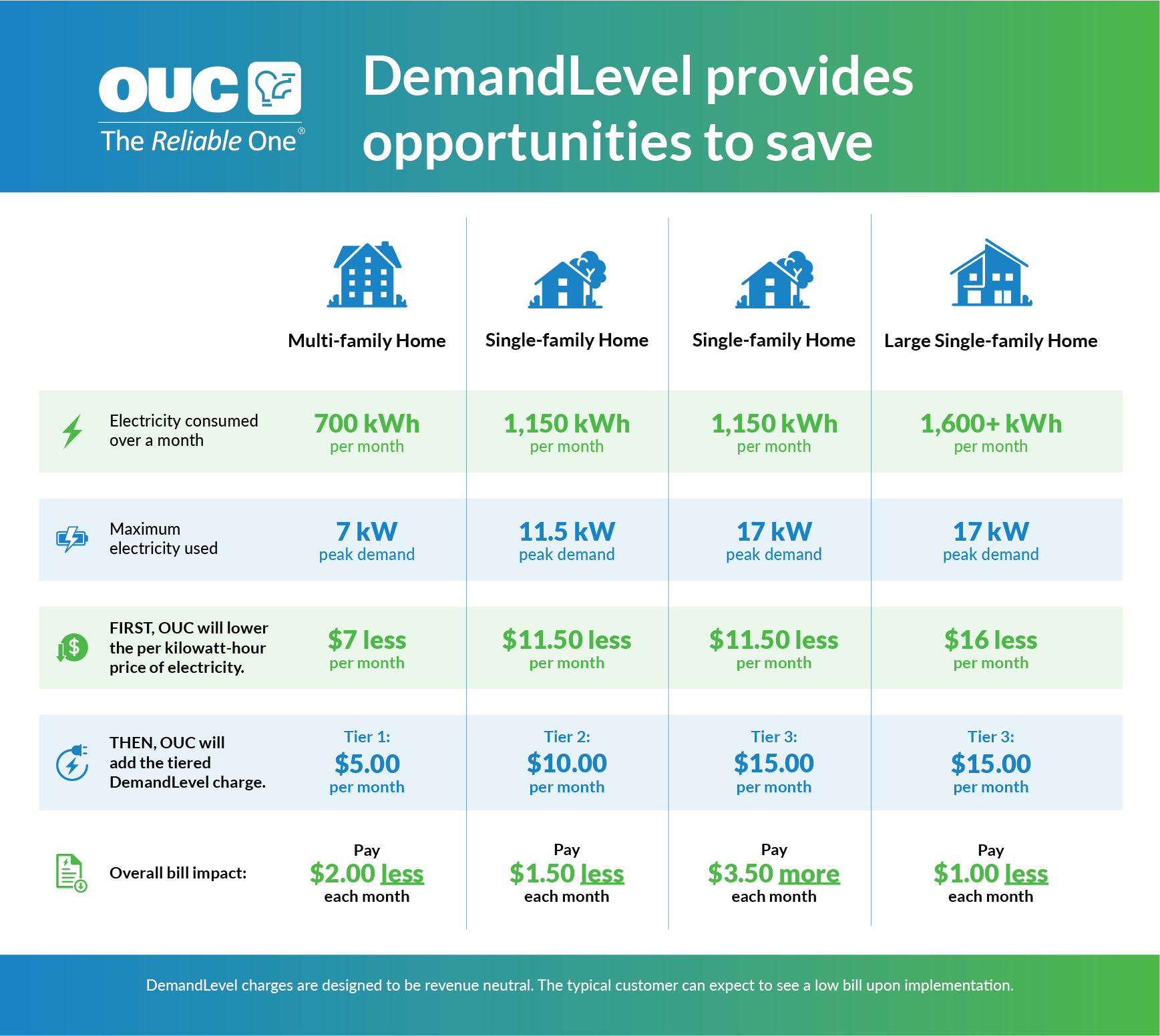Empowering customers with new ways to think about power and save money
A Community-Optimized Energy System
Updates
What is PeakSHIFT?
OUC is proposing to modernize its pricing structure to provide customers with new money-saving options. Called PeakSHIFT, this multi-year transformation is an essential component of OUC’s commitment to achieving Net Zero CO2 Emissions by 2050.
OUC’s “peak” hours are from 2 p.m. to 8 p.m. daily. All other hours are considered “off-peak.”
To learn more about OUC's PeakSHIFT program download the revised presentation from our November 5 recommendation to the Commissioners.
Why do we need an update?
OUC is dedicated to providing affordable electricity, as demonstrated by our well-established record of cutting rates. We understand that recent inflation and the higher cost of living have created hardships. That’s why we developed PeakSHIFT – to protect our customers from the increasing cost of operating the electric grid.

Our modern, electrified world presents new challenges for delivering affordable, and reliable power. The array of challenges impacting OUC operations include:
- Rising Electric Demand
- Weather & Cyber Threats
- Net Zero CO2 Goals
- Electric Mobility
- Increasing Cost Inequities
PeakSHIFT is OUC’s proposal to address these challenges and keep the grid affordable. By redesigning the way we charge for electricity, we can optimize system use and pass those savings along to our customers.
Rising Electric Demand
Weather & Cyber Threats
Net Zero CO2 Goals
Electric Mobility
Increasing Cost Inequities
PeakSHIFT is all about reducing OUC’s peak demand.
What is it?
Peak demand occurs when consumer use of electricity is at its highest, requiring the largest total amount of electricity needed at one moment to keep the grid running.
Why does it matter?
OUC invests in building and maintaining enough grid infrastructure to meet periods of high demand – even if that infrastructure remains unused when demand is lower. How does high peak demand result in higher electric prices?
PeakSHIFT proposes new pricing structures that will help reduce demand to optimize OUC’s grid and save money – which will be returned to our customers through lower prices.
How will implementation of PeakSHIFT address peak demand?
If approved, OUC will make a series of updates in how we allocate the costs of running your electric system. Over the next several years these updates will enable OUC customers to shift their energy uses to non-peak times and take greater control of their bills, resulting in a more optimized grid.
How do OUC’s costs currently correspond to the grid?
When you flip the switch, all the electric system components work seamlessly together to supply your energy...

What steps will PeakSHIFT take?
If approved, OUC will make a series of updates in how we allocate the costs of running your electricity system. Over the next several years these updates will enable OUC customers to take greater control of their bills and result in a more optimized grid.
-
Step 1
Protect customers by ensuring fair electricity pricing
OUC customers live in a wide array of residential settings, from small apartments to large homes, and consume widely different amounts of electricity. “One-size-fits-all” electric pricing no longer works to maintain an equitable, affordable, reliable grid.
Over the next two years, OUC will introduce three new programs to create a solid, balanced foundation for growth. Click on each program to learn more!
TruNet Solar
OUC is a leader in solar power in the Sunshine State, and solar is a critical part of our commitment to achieving our Net-Zero CO2 Emissions goals. We are actively working to provide more solar power to our customers.
The Challenge:
The amount OUC has paid to rooftop solar customers each year is growing, which has caused cost inequities. While solar panels are now cheaper than ever, the cost to OUC for net metering reached about $9 million in 2024. This means each non-rooftop solar customer now pays about $35 each year to customers with rooftop solar. Left unchanged, the projected cumulative amount through 2032 will cost OUC customers $283.1 million.
This is because electricity from rooftop solar costs about three times more than from a utility-scale solar farm. OUC currently pays an average of 4 cents per kilowatt-hour for electricity from its utility-scale solar farms but pays its rooftop solar customers between 11 cents and 13 cents per kilowatt-hour for the same electricity.
If solar panels are now cheaper than ever, why is rooftop solar more expensive? Sixteen years ago, when solar was new technology, OUC started paying rooftop solar owners the full retail rate for their electricity. This rate is equal to what we charge customers and includes grid maintenance costs that rooftop solar owners don’t have. This model was meant to incentivize rooftop solar, but now leads to overpayments that drive up prices for all customers (not just those with rooftop systems).
Proposed Solution:
- OUC will continue to pay the current incentive to existing rooftop solar owners (including all customers who submit rooftop solar interconnection application by June 30, 2025) for a 20-year grandfather period.
- Effective July 1, 2025, all customers who submit a new solar interconnection application will instead be credited for energy exported to the grid at the community solar farm rate for a five-year period ending June 30, 2030, and at the retail fuel rate thereafter.
- An optional Battery storage rebate program will also be offered, with program details coming in the near future.
We value the early adopters of rooftop solar who played a pivotal role in popularizing solar energy within our community. Their forward-thinking investments not only helped to pave the way for wider acceptance and integration of renewable energy sources, but also demonstrated a commitment to environmental stewardship that has inspired many others. The majority of feedback OUC has received about PeakSHIFT has been from these customers, whose contribution to a greener future has been taken into consideration to improve our TruNet Solar program proposal.
Note: Above TruNet Solar program description edited Nov. 5, 2024, to match revised proposal made to OUC’s Board of Commissioners.
-
Step 2
Introduce new ways to control your bill
Shift & Save
The next step of the PeakSHIFT program will allow customers to better manage their bills, ensuring our grid remains stable and sustainable.
Shift & Save
OUC will introduce Shift & Save, an industry-proven, time-of-day pricing plan that enables customers to save money by shifting electricity use into “off-peak” periods.
OUC’s “peak” hours are from 2 p.m. to 8 p.m. daily. All other hours are considered “off-peak.”
By reducing the price of electricity during “off-peak” periods, Shift & Save pricing incentivizes customers to shift energy use away from “peak” to lower demand hours. Savings can be achieved simply by using appliances at different times of the day, such as delaying washing a load of clothes or running the dishwasher until off-peak periods. In OUC’s time-of-day pilot program, 98% of participants were satisfied or very satisfied by the pricing structure and more than half of participating customers reported saving money! Three-fourths of OUC’s pilot program participants elected to remain on time-of-day rates after the program ended.
In addition to promoting conservation, time-of-day pricing will allow OUC to do more with the resources it has, avoiding or deferring costly system expansion.
OUC Shift & Save Pilot Testimonial

How will PeakSHIFT impact my bill?
Overall, PeakSHIFT is a proposed update to how we bill, but not how much we bill our customers. OUC designed PeakSHIFT to be “revenue neutral,” which means that it’s not intended to generate additional revenue for OUC.
These changes are designed to enhance equity, optimize the grid and keep OUC affordable. If approved, you will notice the following on your bill:
| Update | PeakSHIFT program | Explanation |
|---|---|---|
| Cost reduction of per kilowatt-hour (kWh) price of electricity | DemandLevel | Price lowered to offset new DemandLevel pricing. |
| Addition of new $5, $10, or $15 DemandLevel charge, which is determined by your grid use each month. | DemandLevel | Keeps costs low for typical customers, while those who demand more of the grid pay a more proportionate share of the cost to run the grid. |
| Existing customers credited at retail energy and fuel rate for energy exported to the grid for a 20-year grandfather period. New customers credited for energy exported to the grid at the community solar farm rate for 5 years and retail fuel rate thereafter | TruNet Solar | Designed to change the billing process for rooftop solar array owners to address cost inequalities and keep costs low for all customers. |
| Relaunched optional community solar program. | SunChoice | All customers – even those who otherwise could not invest in rooftop solar – can pay a premium to buy a share of clean, emission-free solar power from OUC’s solar farms. |
| Introduction of time-of-day pricing. | Shift & Save | Enables customers to save money by being selective about when they use electricity. |
What has OUC done to receive feedback from the community about PeakSHIFT ?
After first announcing the PeakSHIFT programs on July 3, 2024, OUC has actively engaged in discussions with stakeholders, customers, social and environmental advocacy groups, and other members of our community.
OUC has received considerable valuable feedback from the community about the proposed PeakSHIFT program. To give us time to properly review and respond to this feedback, we decided to postpone our PeakSHIFT program until the November 2024 Commission Meeting to allow us time to revise the PeakSHIFT proposal.
Much of this feedback has been positive. The loudest voices have come from rooftop solar owners and installers who want to maintain net metering.
Feedback by the Numbers (as of September 30, 2024)
- 285,000 OUC's customer base
- 10,300 Net metering customers
- 143 Comments received - through workshop speakers, commission meeting speakers, oucpeakshift.com web form, and emails sent to the public comments or commissioner email boxes. More comments are focused on net metering changes.
- 29 Links, article and studies sent to OUC for consideration
What changes has OUC made to the PeakSHIFT programs as a result of feedback?
OUC has made substantive improvements to both the TruNet Solar and DemandLevel Pricing programs through the incorporation of feedback that we have received.
PeakSHIFT progam |
|
|---|---|
| TruNet Solar | Original proposal |
| All customers move to TruNet Solar and, over a 7-year period, the rate for exported energy is gradually reduced to the published retail fuel rate with a supporting energy storage rebate program. | |
| Updated proposal | |
| Existing customers credited at retail energy and fuel rate for energy exported to the grid for a 20-year grandfather period. New customers credited for energy exported to the grid at the community solar farm rate for 5-years and retail fuel rate thereafter. | |
| DemandLevel | Original proposal |
| For residential customers the fixed charge will be $5, $10, or $15 per month with tier assignment based on annual peak usage. | |
| Updated proposal | |
| Tier assignment based on monthly peak usage. |
What are the next steps before these programs are approved?
After engaging stakeholders and incorporating feedback, OUC made its updated program recommendation for the PeakSHIFT program to its Board of Commissioners at the Nov. 5, 2024 commission meeting.
Next, the Commissioners are anticipated to vote on the proposal at the December 2024 Commission Meeting.
If approved, the PeakSHIFT programs will be rolled out gradually over the next several years.
Frequently Asked Questions
How can I learn more or provide feedback?
You’ll have many opportunities to learn more and get involved! You will be able to join the OUC team at neighborhood meetings throughout our service area in 2025 and 2026. During these meetings, you can discover tips to conserve energy, speak with OUC representatives about OUC’s PeakSHIFT program, and discuss upcoming changes at these public events.
To provide input on the proposed changes, please complete this form.




